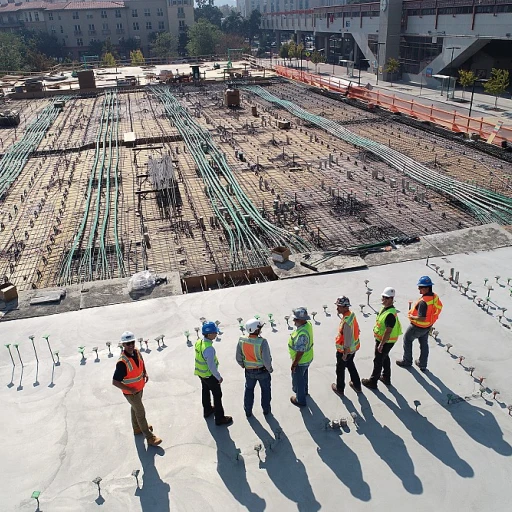
Understanding the Importance of Safety Meetings
The Role of Safety Meetings in Multifamily Management
Safety meetings play a pivotal role in fostering a secure environment within multifamily properties. When managed effectively, they not only enhance the well-being of residents but also contribute to community cohesiveness. To underscore their importance, consider the multi-dimensional benefits they bring to both property managers and tenants. Safety meetings provide a structured platform to address a wide range of safety topics. These discussions can span from fire safety to the maintenance of common areas, covering essential components like workplace safety for employees and the security systems in place. Consistently engaging in such dialogues ensures that recent incidents or potential risks are swiftly identified and addressed, ultimately reducing the likelihood of emergencies. Engagement in these meetings also fosters a sense of community and partnership among residents and management. With an emphasis on effective communication, these gatherings can serve as an opportunity to reinforce best practices and debunk any misconceptions residents might have regarding their safety or the protocols in place. Not only does this build trust, but it also ensures that everyone is well-informed and prepared. The organization of safety meetings is not only a responsive measure but also a proactive step towards mitigating risks and enhancing the multifamily living experience. For further insights into addressing potential conflicts that may arise during such meetings, check out this detailed guide on mastering conflict management in human resources. This integration of safety and communication greatly benefits property management teams and supports mental health by creating a safe, secure living environment for all involved. By understanding the significant role safety meetings have, property managers can effectively prioritize and implement safety protocols that cater to the unique needs of their multifamily communities, ensuring that everyone feels safe and valued.Identifying Key Safety Concerns
Recognizing and Addressing Core Safety Issues
In multifamily properties, understanding the primary safety concerns is critical for effective safety meetings. These concerns are diverse and can impact both residents and employees alike. A thorough examination of these key areas ensures that everyone within the multifamily community can enjoy a safe and secure environment. Identifying common areas of risk is a crucial step. Regular inspection of fire safety measures, including alarms and extinguishers, can prevent potential hazards. Properly functioning emergency systems and clear evacuation procedures can significantly enhance safety. Implementing robust workplace safety protocols ensures that maintenance crews and property management work safely at all times. Residents, too, play a vital role in ensuring safety by being mindful of their surroundings. Encouraging them to report any suspicious activities or maintenance issues can be crucial. Open communication allows for quicker resolutions, thereby enhancing overall security. Beyond just physical safety, addressing mental health concerns is becoming increasingly important in multifamily housing. It's essential to create an environment where residents feel comfortable discussing any concerns, which can be achieved by integrating this into regular safety topics during meetings. In relation to property management, implementing best practices involves continuous assessment and updating of safety protocols. Property managers must consistently monitor and adjust strategies to accommodate any changes within the community or advancements in the field. Understanding these multifaceted concerns means taking actionable steps to safeguard all facets of multifamily properties. For a more detailed discussion on managing safety issues within teams, you might find this conflict resolution resource helpful. It offers insights into overcoming potential challenges and enhancing workplace harmony. The importance of addressing these issues can't be overstated, as it forms the foundation for effective communication strategies poised to follow in the subsequent discussion.Effective Communication Strategies
Strategies to Foster Effective Dialogue in Safety Meetings
Creating an open and effective communication environment is crucial for safety meetings to be fruitful in multifamily properties. Fostering dialogue among residents, employees, and property managers can lead to refined safety protocols and an enhanced community atmosphere.- Encourage Participation: It's vital to ensure every individual attending the meetings feels comfortable expressing their concerns. Encouraging residents to share their experiences about safety issues in common areas or maintenance zones can provide valuable insights.
- Focus on Clarity: Use clear language and avoid jargon to make sure that all participants, regardless of their background, fully grasp the safety topics being discussed. This ensures everyone is aligned with the property's safety objectives.
- Utilize Visual Aids: Incorporate visual tools like charts or diagrams to outline fire safety protocols or other emergency procedures effectively. Visuals can significantly enhance understanding by illustrating complex concepts in a straightforward way.
- Open-Ended Questions: Engage with your audience by asking open-ended questions. This technique not only makes participants more inclined to contribute but also provides diverse perspectives on workplace safety challenges, promoting resident feedback.
Incorporating Resident Feedback
Collecting Valuable Resident Insights
Incorporating resident feedback is crucial when discussing safety meeting topics to ensure a secure and thriving community. Understanding the pulse of those living in multifamily properties not only highlights immediate concerns but also promotes mutual trust between residents and property management.- Empower Resident Voices: Encouraging an open line of communication allows residents to share their experiences and observations regarding safety issues. This could involve informal chats, surveys, or dedicated feedback sessions during meetings.
- Address Common Concerns: Safety concerns in multifamily communities can vary significantly, from fire safety to health-related protocols in common areas. Resident feedback is instrumental in identifying these specific topics.
- Continuous Engagement: Regularly scheduled meetings ensure that residents are consistently involved in safety discussions, fostering a sense of responsibility and partnership in maintaining a safe property.
- Bridge Information Gaps: Often, residents can point out blind spots in current safety protocols, offering insights that might have been overlooked by management and employees.
- Inclusive Approach: By involving residents in the decision-making process regarding safety improvements, property managers can develop a more comprehensive and effective safety system, enhancing the security and wellbeing of the entire community.
Training and Preparedness
Equipping for Emergencies: Training and Preparedness
In multifamily properties, ensuring the safety and security of residents and employees hinges on effective training and preparedness. It's crucial for property managers to create a structured safety system that encompasses regular safety meetings and workshops designed to keep everyone informed and ready to tackle emergencies such as fire outbreaks or other hazards. First and foremost, these safety meetings should include comprehensive training sessions tailored to the specific needs of your community. Topics multifamily properties might cover include:- Fire safety procedures and evacuation protocols
- First aid and mental health support during crises
- Security threats and package theft prevention
- Proper use and maintenance of fire extinguishers and other safety equipment
Evaluating and Improving Safety Protocols
Assessing Current Safety Protocols
To ensure the safety of residents and employees in multifamily properties, it's crucial to regularly evaluate existing safety protocols. This involves a comprehensive review of all safety measures currently in place, including fire safety systems, emergency response plans, and maintenance procedures. Property managers should conduct routine inspections of common areas and other key locations to identify any potential hazards or areas for improvement.
Gathering Feedback and Data
Incorporating feedback from residents and employees can provide valuable insights into the effectiveness of current safety protocols. Regular safety meetings offer an opportunity to discuss safety topics and gather input on potential improvements. Additionally, analyzing data from past incidents or near-misses can help identify trends and areas that require attention. This data-driven approach ensures that safety measures are not only reactive but also proactive.
Implementing Changes and Best Practices
Once areas for improvement have been identified, it's important to implement changes promptly. This may involve updating safety training programs, enhancing communication strategies, or investing in new safety technologies. Property managers should stay informed about industry best practices and incorporate them into their safety protocols. Regular training sessions for employees and residents can reinforce these changes and ensure everyone is prepared in case of an emergency.
Continuous Improvement and Monitoring
Safety is an ongoing process that requires continuous monitoring and improvement. Establishing a system for regular review and updates of safety protocols ensures that they remain effective and relevant. Property managers should schedule periodic safety meetings to discuss new safety topics and review the effectiveness of implemented changes. By fostering a culture of safety and continuous improvement, multifamily communities can maintain a safe and secure environment for all residents and employees.












